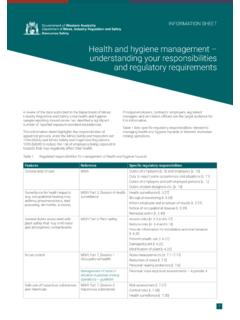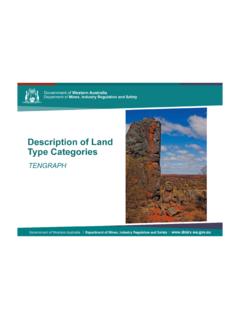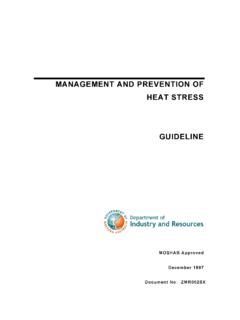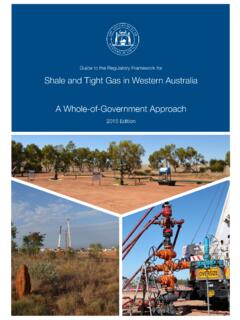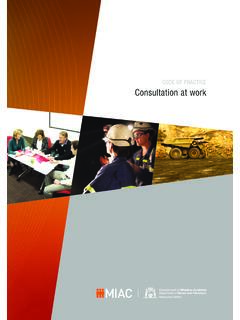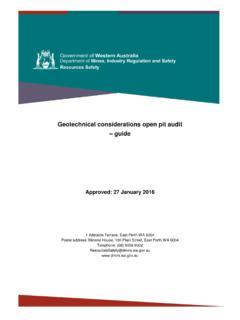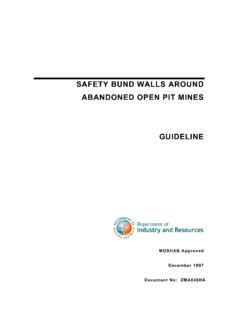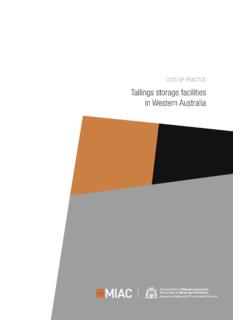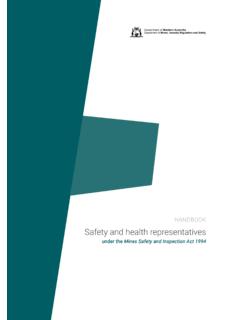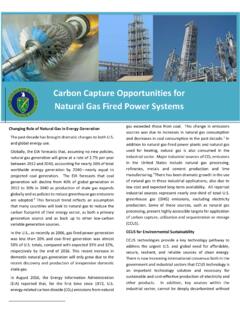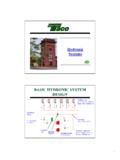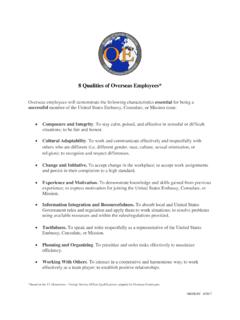Transcription of UNDERGROUND VENTILATION (METALLIFERROUS MINES) …
1 UNDERGROUND VENTILATION (METALLIFERROUS MINES) GUIDELINE MOSHAB Approved December 1997 Document No: ZED569LF Department of Industry and Resources Document No. ZED569LF UNDERGROUND VENTILATION (Metalliferrous Mines) CONTENTS Page LEGISLATIVE REQUIREMENTS (WA) ..4 DESIGN Primary Primary secondary General Planning and Operating SPECIFIC Gas Oxygen Blasting Issued.
2 December 1997 Page 1 Version UNDERGROUND VENTILATION (Metalliferrous Mines) Document No. ZED569LF Department of Industry and Resources FOREWORD This Department of Industry and Resources (DoIR) guideline is issued to assist in the understanding of UNDERGROUND VENTILATION in metalliferrous mines, and to provide guidance, at the practical level, on essential design aspects and operating practice. It is not a comprehensive technical document and does not deal in detail with VENTILATION practice for specific tasks or operating procedures.
3 The procedures outlined in the body of this guideline are not regulations, and compliance with them is not mandatory. However, adherence to the procedures indicated should ensure a high level of worker health protection. Procedures different from those set out in the guideline may also be acceptable. Comments on, and suggestions for, improvements to the guideline are encouraged. The guideline will be revised as appropriate, to accommodate comments and to take account of new information on improvements in technology and operational experience.
4 Safety Health and Environment Division Department of Industry and Resources 100 Plain Street EAST PERTH WA 6004 TEL: (08) 9222 3333 FAX: (08) 9325 2280 Page 2 Issued: December 1997 Version Department of Industry and Resources Document No. ZED569LF UNDERGROUND VENTILATION (Metalliferrous Mines) INTRODUCTION VENTILATION in an UNDERGROUND mine is of critical importance to the occupational health and safety of UNDERGROUND employees. The atmosphere UNDERGROUND is limited and confined, and is thus readily reduced to a sub-standard (or even dangerous) condition if contaminants produced in the course of operations are not controlled, or safely extracted or diluted to harmless levels.
5 The contaminants may include dust, aerosols, diesel fumes and particulates and fumes from blasting, as well as gases released from the rock strata. Reduction of oxygen may result from oxidation of reactive sulphides under some circumstances. Oxygen reduction may also take place due to recirculation of ventilating air where diesel engines are operating, and in unventilated areas where "standing" water is present. It is essential to maintain levels of temperature, humidity and air velocity in the workplace such that employees do not suffer detriment to health from exposure to extremes of heat, humidity or cold.
6 Of equal importance to the maintenance of a healthy working environment UNDERGROUND is the need to protect employees against the risk and the consequences of UNDERGROUND fires and unplanned explosions, including sulphide dust ignitions. Correct design, implementation and maintenance of mine VENTILATION is therefore of fundamental importance. In present day mining, VENTILATION systems designed and operated to maintain efficient operations will normally enable a high standard of occupational health and safety to be achieved.
7 Issued: December 1997 Page 3 Version UNDERGROUND VENTILATION (Metalliferrous Mines) Document No. ZED569LF Department of Industry and Resources LEGISLATIVE REQUIREMENTS (WA ) The Mines Safety and Inspection Regulations 1995 has many requirements that apply to issues referenced in this guideline. Listed below are the regulation numbers and the short reference labels, the full text should be read in order to fully comprehend the scope of the legislation. Regulation Workplace atmospheric contaminant monitoring to be provided Qualifications of VENTILATION officer Duties of VENTILATION officer - UNDERGROUND VENTILATION log book VENTILATION system defects to be rectified Exposure standards Control of atmospheric contaminants Air in UNDERGROUND workplaces Air temperature
8 Air sources Ventilating fans and equipment Control of air distribution UNDERGROUND Fumes from blasting Tailings filled stopes - atmospheric contaminants VENTILATION system may be cut off in disused areas VENTILATION plans for UNDERGROUND mines Monitoring of toxic, asphyxiant and explosive gases DESIGN CONSIDERATIONS Primary VENTILATION The basis of effective VENTILATION of UNDERGROUND mines is the adequacy of the primary VENTILATION system, that is the total volume flow through the mine which is conducted through the major UNDERGROUND workings, normally involving splits into parallel circuits.
9 Factors which determine total primary volume capacity (and pressure) requirements for a mine include the extent and depth of the mine, the complexity, and the stoping and extraction systems, together with the size of development openings and the equipment used. Page 4 Issued: December 1997 Version Department of Industry and Resources Document No. ZED569LF UNDERGROUND VENTILATION (Metalliferrous Mines) One of the major constraints on primary VENTILATION volume which is sometimes not adequately provided for at the design stage, is intake air capacity.
10 Whereas high air velocities may be tolerable in return airways and exhaust rises and shafts, (where no personnel are exposed), there is a practical limit to tolerable air velocity in main intakes (shafts and declines) and main development openings where persons travel and work. Dust generation is one problem deriving from intake velocities in excess of 6m/sec. Moreover, high velocities require high pressure gradients and very high power costs to maintain them. A further major consideration with deep and extensive UNDERGROUND mines is the tendency to lean towards series VENTILATION circuits.
